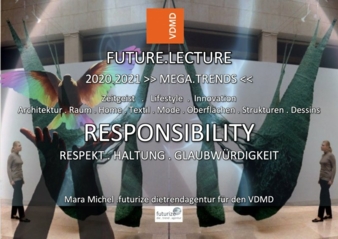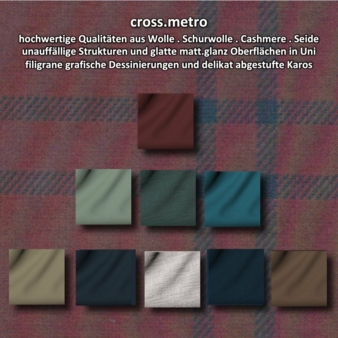26/07/2019 – Autumn/Winter 2020/21 — auf Deutsch lesen
VDMD-Trend Research: Responsibility
Responsibility for Winter 2020/21 gives physical reality to respectful interaction with one another, a new attitude that includes getting involved.
It’s about acting authentically and listening to one’s inner self.
Each season the VDMD Trend Research Team prepares a ‘Forecast Future Concept’ taking up socially relevant topics that are illustrated, materialised and visualised directly in fashion and textiles. As for every season there are four major topics that are reflected in new materials and fabrics: cross-metro, cross-balance, cross-continental and cross-thinking.
1. cross-metro
The first topic is concerned with slowing down, with free spaces and with new communication systems in the urban environment. Places for encounters in the heart of the city, more green spaces, more self-determined time.
The colours exude peace, are unobtrusive and yet emotionally charged. Dark and recessive against clear and fresh. Using colour to slow us down.
We can disappear in the concrete.
Business colours as coded reflections of anonymity.
The materials, their structures, surfaces and prints may appear imperfect, due to living, sandy, velvety or even opened structures on a monotone background. What is new is the reappearance of diamond shapes, which may be overprinted with soft graphic structures and embroideries offering personal statements. The added benefits of smart elements become obligatory, sustainability becomes a given.
Accessories and decoration are matched to the nature of the statements.
An important dimension is that of authentic materials that meet the demands of sustainability, preferably sourced in the region and requiring only short journeys.
2. cross balance
The second topic references our responsibility towards nature, in the sense of the cradle-to-cradle concept, avoidance of over-consumption, materials in a closed lifecycle. To this end, production journeys need to be adjusted, prices prudently calculated and waste materials sensibly re-used.
The colours serve to reflect the elements of water, earth, fire, air and metal.
We accompany the colours into the depths of nature and let them take their effect on us.
The materials, their textures, surfaces and prints are borrowed from nature. Old materials are consciously revitalised and drawn from the local region, making possible a new yet old diversity. The exploration and exploitation of newly discovered materials creates quite new visual effects. Casein fibres, algae, kelp, fruit fibres, hemp, soya silk, pineapple leather and apple/pomace leather lead to products that become more personal, more individual. Single designs that are closer to personal wishes become possible.
Accessories and decorations are of recycled wood or upcycled plastics.
3. cross continental
The third topic picks up the thought of migration.
History and culture are seen from an inter-continental angle. They are not evaluated, but rather observed and taken up. This means having the courage of one’s opinions and perceptions. It means approaching other cultures with curiosity, openness and an absence of prejudice, and not transferring one’s own demands to other models of society.
We pursue what happens in the process when we have set something in motion for the purpose of change. The colours are emotionally charged. They are drawn from all continents and absorbed into our culture. Our very own perception of colour is enriched and becomes more flamboyant. In opposition lies liveliness and an openness that unites.
The materials, their textures, surfaces and prints become personalised. We use digital prints, embroidery, crochet, knitting. Art deco, art nouveau, pop art, fantasy, the surreal – all styles can be juxtaposed for new visual effects.
Digital print beside 3D print, laser beside silicone, reliefs beside mirror-smoothness, old handicraft is celebrated beside tattoos, sawn materials and old craft techniques.
Accessories and decoration are retrieved from the archives and redeployed.
4. cross thinking
The fourth topic involves young people and learns from them, from their storms of innovation. From think-tank to make-tank.
Thinking towards the future, developing utopias for a positive human future.
Looking beyond the close horizon, sitting together, contemplating and developing something new.
Developing innovations without the expectation of an immediate result.
The colours are powdery like the soul, light and young. They are free shades, free of fear and with a subtle symbolism that permits openness, that allows space.
The materials, their textures, surfaces and prints are not just smooth and gleaming but broken in many places. Statements are worked into the template, codes are brought to the fore. Synthetically created materials are formed from microbes and nature’s waste. New techniques are employed for unique individual designs. Iris van Herpen is a major role model. To the fore are softness and a feeling of being at home. Materials reflect the need for sensitivity and must trigger new impulses with the mastered techniques. Cashmere and down are preferably synthetic. Fibres, yarns and materials and algae, synthetic fish leather, animal hair without killing animals, leathery materials from tea fermentations and fruit fibres. Discoveries that have lain in the drawer are now brought out into the light.
Accessories and decoration are designed in the same basic materials as the fabrics. A season full of surprises and new visual effects.
Mara Michel, Managing Director VDMD





